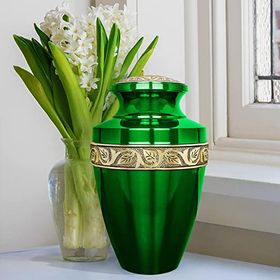Urn Size Guide: Do You Need a Small, Large, or Extra Large Urn?
Published April 30, 2022

If you’ve chosen the path of cremation for a loved one, you probably have a few questions about the size of the urn you’ll need. The urn size influences the style, design, cost, and material of the urn you choose. The outside dimensions of an urn will vary according to its shape and design. The inside of the urn is known as the capacity, and cremation urns are measured in cubic inches. In this article, we’ve put together a basic guide on how much ash is left after the cremation, as well as an urn size calculator and a cremation weight calculator.
How Much Ash Is There After Cremation?
The word “ash” is generally used to describe the substance left over after cremation. However, contrary to popular belief, the cremains are not ashes at all. For the most part, they are calcium phosphate together with other minerals like sodium and potassium.
Generally, the cremains are around 3.5% of the person’s total body weight and will weigh between 4 and 6 pounds. In the case of children, the cremains are around 2.5% of the total body weight. There are also various other factors that affect the amount of cremains, including:
Bone density: the greater the bone density, there more ashes there will be, especially because the cremains are mostly made up of bone matter.
- Age: younger individuals usually have a greater bone density than older people.
- Gender: men tend to have greater bone density than women.
- Height: the taller the person is, the more bone there will be.
A basic method to calculate the amount of ash after the cremation is to use the person’s total body weight and multiply that by 3.5%.
For example, if a person weighed 150 pounds: 150 pounds x 3.5% = 5.25 pounds of cremains.
Urn Size Calculator
To find the perfect urn for your loved one, you will need to know what size you’re looking for. Different body sizes will affect the size of the urn.
The general rule when it comes to calculating urn size is 1 of pound body weight equals 1 cubic inch of ash.
For example, if a person who weighs 100 pounds is cremated, it will yield roughly 100 cubic inches of ash, so that the person would need an urn with at least 100 cubic inches of space.
Standard Urn Dimensions
Small and Medium Urns
Small and medium urns are best for dividing one person’s ashes among two or more people, as well as for young children. Small and medium urns hold anywhere between 20 to 150 cubic inches of ash.
Individual Urns
Individual urns are the most common urn size for adult urns. They hold around 180 to 250 cubic inches of ash. Standard urn dimensions will hold the ashes of an average-sized adult.
Extra Large Adult Urns
If needed, extra-large urns hold between 250 to 350 cubic inches of ash.
Companion Urns
Companion urns hold the ashes of two different people, usually a couple. More often than not, companion urns have two separate compartments, and as a whole, the urn holds 350 to 500 cubic inches of ash.
Keepsake Urns
Keepsake urns hold a small portion of ashes and are a great way to share the cremains among family members. Keepsake urns hold between 3 to 15 cubic inches of ash and they come in all sorts of shapes and sizes.
Niche Size Urns
Standard columbarium niches are generally 12-inch cubed. A columbarium is used for cremated remains in which there are many niches that hold urns. If you are looking to place the urn in a niche, you will need the right size urn. Box-type urns are often rectangular with dimensions between 6 to 9 inches. Vase-type urns are typically between 9 to 13 inches tall.
Display Urns
The size of a display urn will depend on your personal preference. Some display urns are the size of individual urns or companion urns, while others are a lot smaller and are the size of keepsake urns.
Scattering Urns
Scattering urns are generally designed to hold all the person’s ashes, which are typically between 180 to 250 cubic inches of ash. However, you also get smaller scattering urns which hold a quarter of the cremains.
Bio Urns
The standard size of a bio urn is 200 cubic inches, but smaller or larger ones are also available to fit between 170 to 300 cubic inches of ash.
Pet Urns
Pet urns are available depending on the size of your pet. If your dog weighed 50 pounds, you would need an urn with 50 cubic inches of space. A keepsake urn is a great option for smaller pets.
In Conclusion: Which Size Urn Should You Choose?
A good piece of advice is to remember that an urn can only be too small for the ashes but not too large. You need a cremation urn that has a larger capacity than the amount of cremains you have. Too much space is perfectly fine, and you can choose to fill it with keepsakes or memories of your loved one.





